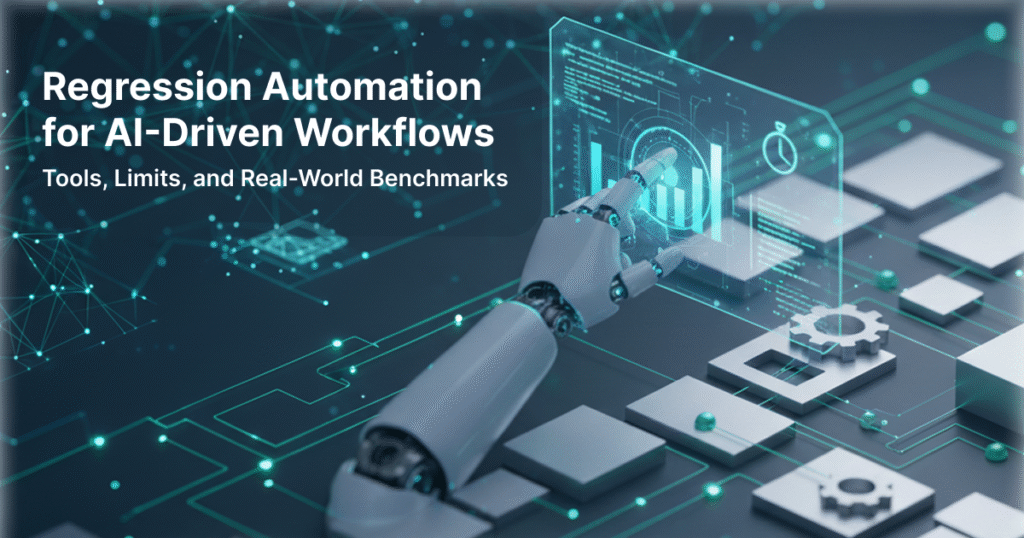Artificial Intelligence (AI) is no longer a futuristic concept — it’s powering everything from chatbots and fraud detection systems to recommendation engines and autonomous vehicles. But with rapid model updates, continuous data changes, and frequent pipeline modifications, one major challenge emerges: how do we ensure nothing breaks when we ship updates?
This is where regression automation for AI-driven workflows becomes a game-changer.
In traditional software development, regression testing is about verifying that new changes don’t break existing functionality. But in AI systems, things are far more dynamic. A simple dataset update or a small change in the model architecture can cause significant shifts in predictions or performance metrics. This makes automated regression testing essential for delivering reliable AI systems at scale.

Regression Automation in AI Workflows Means :
Regression automation in AI workflows is the process of automatically re-testing AI systems whenever changes occur — whether in data, models, pipelines, or infrastructure — to ensure they continue to function and perform as expected. Unlike traditional regression testing that focuses on UI or APIs, AI regression goes deeper. It includes model regression, verifying metrics like accuracy, precision, or F1-score haven’t dropped; data regression, ensuring new data doesn’t introduce bias or quality issues; pipeline regression, confirming end-to-end workflows still run correctly; and integration regression, checking that downstream systems using AI outputs behave as intended.
Beyond these areas, regression automation also supports scalability, reproducibility, and continuous delivery. Since AI models evolve rapidly with frequent updates and retraining, automated regression helps detect performance issues early, speeds up release cycles, reduces manual effort, and builds trust. Ultimately, it’s not just about verifying functionality — it’s about ensuring confidence, reliability, and consistent performance in a continuously changing AI ecosystem.
Why Regression Testing Is More Complex in AI :
In regular software, regression testing is pretty simple — you run the same inputs and expect the same outputs every time. But AI doesn’t work like that. It keeps learning and changing, which makes testing much trickier. For example, a retrained model might give slightly different results even with the same data, so you can’t always expect identical outputs. AI is also very sensitive to data, meaning even small changes in the data’s quality or distribution can cause big differences in predictions. On top of that, a model might still run but perform worse — for example, it could have lower accuracy or make more false predictions. And because AI workflows are complex and involve many steps (like data processing, feature extraction, and prediction), every part needs to be tested to make sure the whole system works smoothly.
All of this means traditional testing methods aren’t enough. Regression automation for AI has to be smarter — aware of data, focused on performance, and able to test the entire pipeline to catch problems before they reach users.
Best Tools for AI Regression Automation :
Selenium + REST Assured + Postman – Serving Layer Regression
When it comes to AI systems, the serving layer is where real users interact with predictions — through web apps, APIs, or dashboards. Testing this part is crucial because even small issues here can directly affect user experience and business decisions. A powerful and practical toolset for automating regression at this layer is Selenium, REST Assured, and Postman.
Selenium is used for automating the UI layer, ensuring that predictions display correctly on the screen, forms work as expected, and the overall user experience remains stable after updates.
REST Assured handles API automation, verifying that model predictions, response times, and data formats stay consistent even when the model or data changes.
Postman is great for manual exploration and quick regression checks, helping you test and validate APIs before fully automating them.
A typical project setup might include folders for UI tests (Selenium scripts), API tests (REST Assured), utilities for configuration and test data, and Postman collections for quick runs. The workflow usually starts with exploratory testing in Postman, followed by automated API checks with REST Assured, and ends with UI validation using Selenium. Finally, you integrate everything into a CI/CD pipeline to automatically run tests whenever the model or system is updated.
This combination ensures the entire serving layer — from API to frontend — stays stable and accurate, even as your AI system evolves.
The Limits of Regression Automation in AI :
While regression automation is powerful, it’s not a silver bullet. AI brings some unique limitations that testers and data scientists need to plan for:
1. Human judgment is still required: Subtle shifts in predictions or decision-making may require expert review to interpret.
2.Metric sensitivity: Detecting small performance drops often requires statistical analysis, not just fixed thresholds.
3.Labeling costs: Regression testing often needs new or updated labeled datasets, which can be expensive.
4.Bias and fairness: Automated tests might miss new biases introduced during retraining unless explicitly designed to catch them.
Real-World Benchmarks: Regression in Action :
Regression automation proves its value in many real-world AI applications. For recommendation systems, a drop in Precision@10 from 0.89 to 0.84 was caught by the regression suite, triggering a rollback before users were affected. In fraud detection, a small change in F1-score from 0.92 to 0.918 was within acceptable limits, allowing deployment to continue, but the tests scheduled a recheck to ensure stability. For NLP chatbots, regression tests evaluated intent classification accuracy, entity extraction precision, and latency under load — revealing a latency regression even as accuracy improved. These examples highlight that automated regression helps catch performance drops and ensures AI systems remain reliable across multiple dimensions.
Final Thoughts :
AI systems are constantly changing and learning, so they’re very different from traditional, static software. That means normal testing methods aren’t enough to ensure they keep working well. Regression automation helps bridge this gap by continuously checking every part of your AI workflow — from data and models to pipelines, APIs, and performance metrics.
When done properly, regression automation doesn’t just catch problems — it actually helps teams move faster. With a solid regression pipeline, you can deploy updates more quickly, update models safely, and deliver AI-powered products that users can trust. In the end, the future of AI isn’t just about building smarter models — it’s about testing smarter too.
Search
Categories

Author
-
I am Lakshmipathi, a dedicated QA Engineer with over 2 years of experience in manual and automation testing. I have strong skills in web and API testing, writing effective test cases, and validating data using SQL. My expertise includes tools like Selenium, Postman, JIRA, and TestNG, along with Java for automation scripting. I focus on delivering high-quality, user-friendly applications while collaborating closely with development teams. With a passion for continuous learning, I aim to grow further and contribute to building reliable software solutions.
